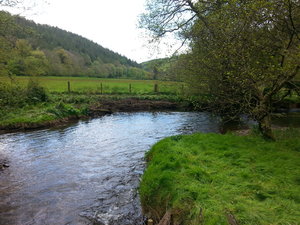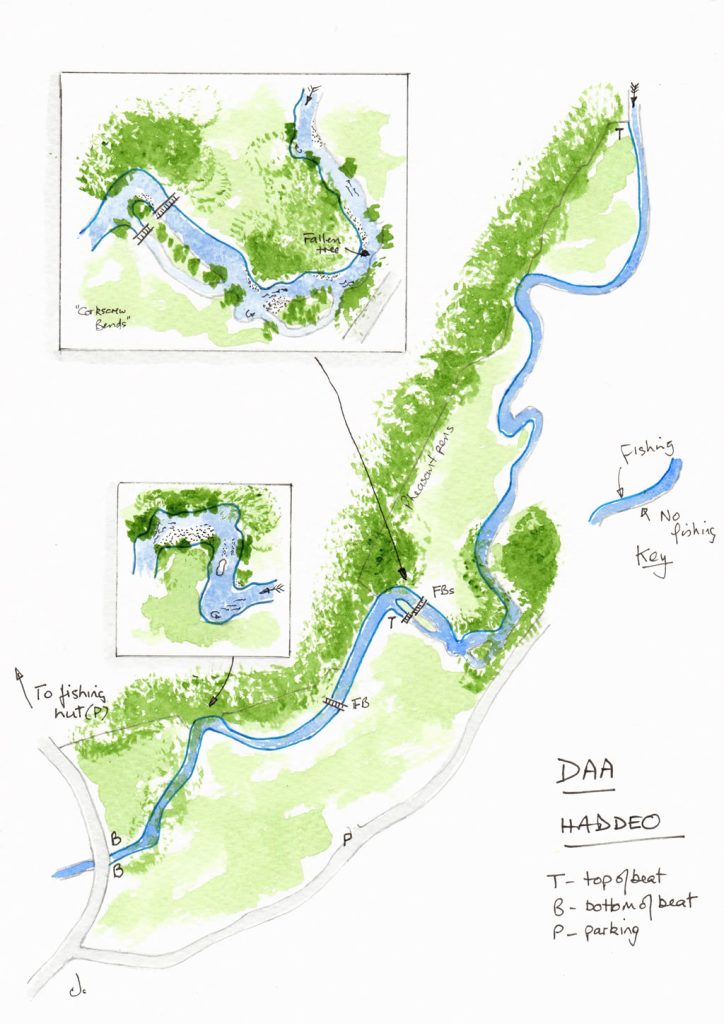Haddeo Beat
The River Haddeo is the river that feeds and then emanates from Wimbleball Lake.
From the top of the beat the river runs downstream under the A396 to the point where the river joins the Exe on Perry beat. Its passage can best be described as characterful, with plenty of variety both in terms of the topography and the fish caught. You are just as likely to catch a salmon smolt as a Brownie. The river is never very wide, and a smaller rod is probably an advantage on this beat. Access is generally good and whilst there are again cables crossing the beat at a couple of points they are not in prime fishing sites. Wading is easy with thigh waders general sufficient.
Parking is either at Weir Yard with a short walk to the beat or at the point marked on the beat map.
Frank McBratney a long time DAA member and Haddeo regular reflects on his experience below:

A nice deep pool on the Haddeo
“Fishing the Haddeo makes a lovely half-day or more in quiet moorland farming country, for it is private water, hidden from tourists and dog-walkers. It is often feasible to fish the Haddeo when there is too much water running off the moor, and the Little Exe and the Barle are in spate. The Haddeo usually fines down sooner than its sister streams after a storm. This is because floodwater from the upper part of the river is impounded and normally held up by the dam, and the lower part drains only its own small valley. The converse of this is that the water level of the Haddeo can sometimes be lower than is natural, because of the dam. It is therefore not the best of streams to fish in a long, dry spell. However, there is a river-conservation agreement for “compensation water” to be released from the dam from time to time, and this invigorates the river and improves the fishing when it happens – not only in the Haddeo but all the way downstream through the Little Exe and into the Exe itself.
DAA’s Haddeo beats lie in the small valley below Wimbleball, at the heart of a busily-keepered private estate. There are no public footpaths on the beats that we fish. They run for nearly a mile on both banks upstream of the junction pool, but the river tumbles and glides down from the dam through a relatively flat valley for a few miles before you come to our water. It makes a pleasant and instructive walk to amble downstream from Hartford to Bury on the public footpath until you reach the private land that contains the DAA beats.
The river holds wild Brown Trout, Salmon Parr, Smolts, some Grayling, and occasionally non-breeding escapee Rainbow Trout gone wild. The Haddeo is a valuable site for salmon spawning, consequently an essential nursery for juvenile Salmon, and for the other salmonids. Conservation work to improve the river ecology has been going on for years, supported by many environmental organisations and other interested parties, not least DAA and members of its winter working parties. On our beats there are runs, riffles, pools, corkscrew bends, and deep holes under the boles of trees – and all produce fish at one time or another, angled by one technique or another. Strands of Ranunculus hold here and there in the riverbed, providing food and shelter for fish. There is a rich aquatic fly life during all stages of growth, occasional mayfly, and there is an abundance of (mainly black) terrestrials throughout the season, notable in spells of warm and muggy weather. Tying on small flies and “nothing fancy” makes for better tactics than the opposite approach, although west-country flies tend to be a bit fuller and brighter than those used elsewhere. Dry fly fishing can be very successful if you can fairly-closely match the hatch. Whichever angling method adopted, and whichever flies selected, local and seasonal imitative fly and nymph patterns probably do best of all. Lance Nicholson’s staff in Dulverton stay very well informed about who’s catching on which flies throughout the season, and they give good advice to the visiting angler as conditions and results change.
On the Haddeo, you have lies that you can fish up, down, dry, wet, and by nymph and almost any fashionable method including Tenkara. The quarry are small, beautifully marked, fully finned and strong. Brown Trout are generally 3 or 4 to the pound. A 9” or 10” fish is a good one, bigger ones are caught occasionally. DAA advocates catch and release to preserve stocks, – except for Rainbow Trout of all sizes, which we ask to be killed because they are a non-native species and compete, probably too successfully, with our wild fish in a fragile habitat that we are working hard to improve.
Light tackle, say AFTM 3-6, and 2-3lb chameleon-coloured leader is good. There is an interesting argument about the best length of a fly rod on water like this, i.e. short versus long say from 6’ to 9’; short for orthodox casting, long for working the fly with the rod-tip through pocket water and tree-hung spots. Make your choice, but a standard 8’6” fly rod will suffice, as it does almost everywhere.
Take a sandwich in your bag if it’s a lovely day, or even if it’s poor weather and in case the fish are taking. Otherwise, find nearest refreshment to the Haddeo at lots of different places in Dulverton or at The Anchor, Exebridge. Tight lines!”

